Ever wondered if the majestic teak wood in your backyard can flaunt a fresh coat of paint? Let’s dive into the possibilities and uncover the secrets to mastering this tricky task together!
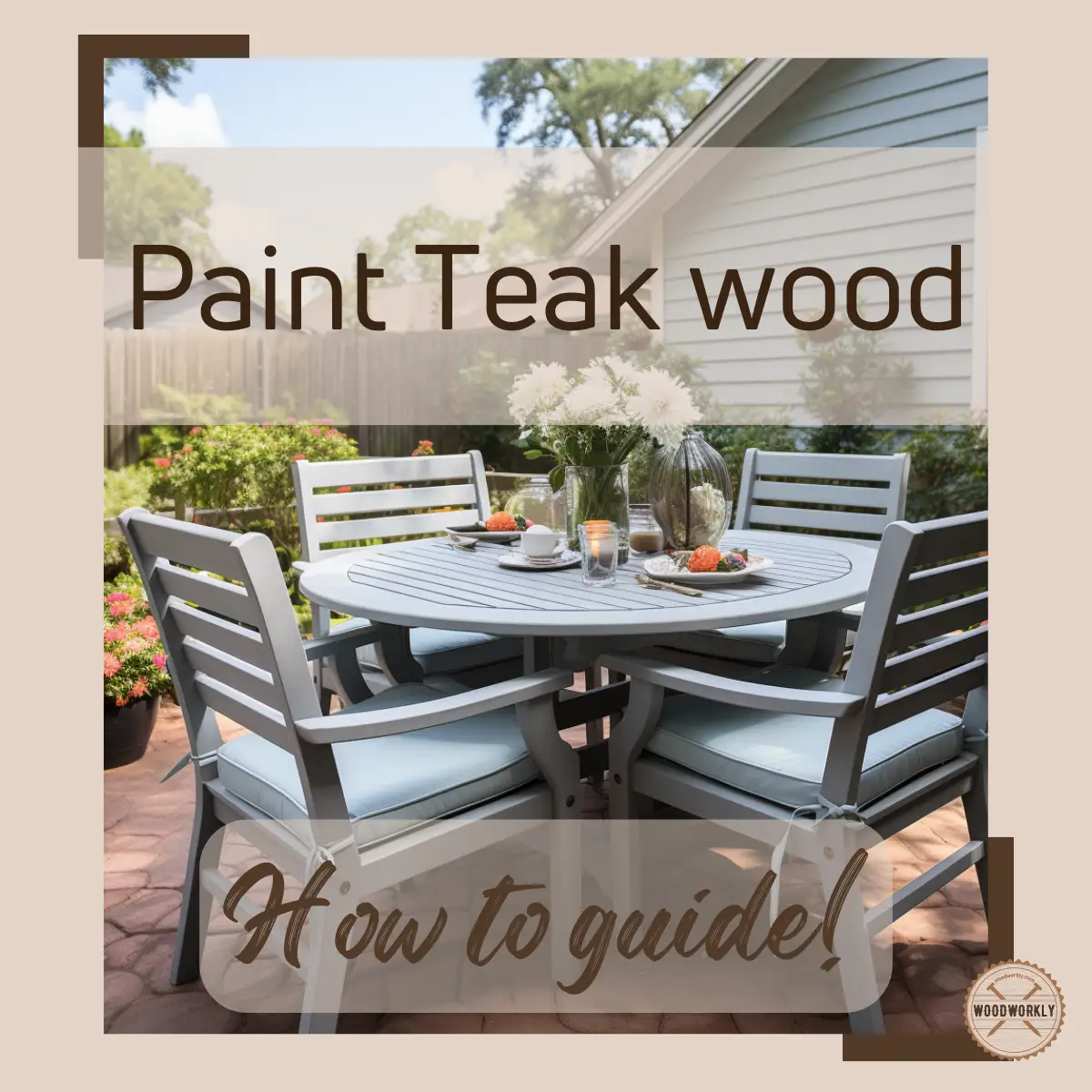
Are you ever worried about the aged teakwood patio?
Once, It’s been enhancing the beauty of your garden. But lately, it’s started to show its age because the sun, rain, and time have left their marks.
However, you don’t need to worry about it anymore!
Instead, start walking through this guide to learn from my experiences.
This was a situation I found myself struggling some time ago. Several teakwood finishes in my garden paled with color and appearance.
So, the idea of painting those furniture popped into my head like a lightbulb moment.

On one hand, I wanted a fresh, vibrant look and durability.
On the other hand, I did not want to lose that natural charm that made teak so special. But, like you now, I had no knowledge about teakwood painting in those days.
I decided to dive into the world of teak wood with the help of experts. And today, I’m excited to share what I discovered and take you along on this journey.
So, let’s find out, can you paint Teak wood?
Yes, you can paint teak wood, but it requires thorough preparation due to its natural oils that inhibit paint adhesion. Cleaning the wood, filling holes, scuffing the surface, applying a stain-blocking primer, and using at least two coats of paint are essential steps for a successful application.
There’s a lot more to know.
In this article, we’ll look at whether it’s a good idea to paint teak wood. Also the following areas will be covered too.
- which paint works best,
- the supplies you’ll need,
- how to paint teak wood furniture with detailed steps,
- tips for doing it right,
- how long the paint will last on teak wood, and how often you should repaint it.
No more further delays, Let’s jump in!

Is It OK to Paint Teak Wood?
Yes, it is possible to paint teak wood, but there are important considerations and steps you should be aware of before starting on this project.
Teak wood is renowned for its natural beauty, durability, and resistance to the elements, making it a popular choice for both indoor and outdoor furniture.
However, many people think about going with the idea of painting their teak wood furniture for various reasons, such as wanting to change the color or to refresh old, weathered pieces.

Pros and Cons of Painting Teak Wood
But, it’s important to note that painting teak wood has pros and cons.
| Advantages | Disadvantages |
|---|---|
| Painting can deepen the color of the wood and draw attention to the warm grain patterns. | Paint can hide the natural beauty of teak wood. |
| Paints give an extra layer of defense against moisture and UV rays, extending the life of the wood. | Teak’s natural oils can make it challenging for paint to adhere, potentially causing flaking or peeling. |
| Painting allows you to match your furniture to your desired color scheme or decor. | Painted teak may require periodic repainting to maintain its appearance. |
| Painting can be a great way to restore old or weathered teak wood, giving it a fresh, new look. | Properly preparing teak wood for painting can be time-consuming and require sanding and sealing. |
| Painting helps prevent water from penetrating the wood, reducing the risk of rot. | You’ll need to choose paint specifically designed for outdoor use to withstand the elements. |
Painting teak wood can be a viable option, especially for weathered or older pieces of teak furniture that need a new lease on life.
However, it’s important to be aware of the potential drawbacks, like the need for proper preparation and maintenance.
In the following sections, we’ll delve into the process of painting teak wood, including the best types of paint to use and the steps to follow for a successful transformation.

Best Paint For Teak Wood
Now we’ve confirmed that painting teak wood is possible and explored the considerations.
Let’s dive into the aspect of choosing the right paint.
The choice of paint is important in achieving a beautiful, long-lasting finish for your teak wood furniture.
Teak wood is unique due to its high oil content, which means using regular wood stains won’t work.
Instead, you’ll need specially formulated teak stain to ensure the paint adheres properly and doesn’t damage the wood

Here’s what you need to know about paint options suitable for teak wood and their respective advantages and disadvantages.
Oil-Based Paints
When it comes to teak wood, oil-based paints are a popular choice.
These paints have the ability to deeply penetrate the wood, highlighting its natural color and providing a shield.
Oil-based paints are particularly well-suited for outdoor teak wood furniture due to their durability in the face of changing weather conditions.
Furthermore, using oil-based paint eases the process of blending with wood oil than other paint formulations as teak wood contains high levels of natural oils which
Advantages of Oil-Based Paints:
- Deeply penetrates the wood, enhancing its natural beauty.
- Provides excellent protection from moisture and UV rays.
- Ideal for outdoor use and any weather conditions.
Disadvantages of Oil-Based Paints:
- Longer drying times compared to water-based paints.
- May require additional ventilation due to the fumes during application.
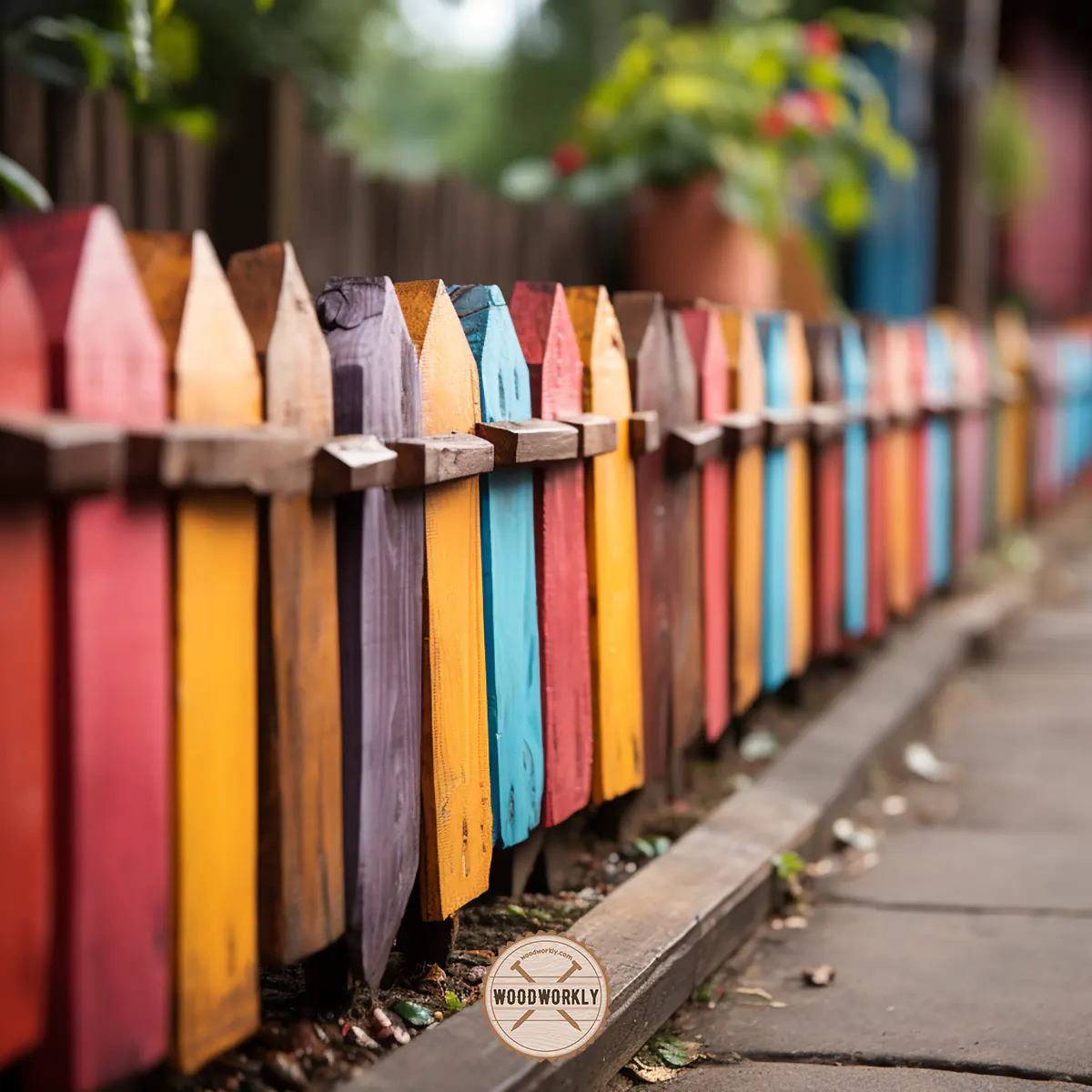
Water-Based Paints
Water-based paints offer a different set of advantages.
They are known for their quick drying times, making them a convenient choice for those looking to complete their teak wood painting project swiftly.
These paints are also eco-friendly and come in a wide array of colors, allowing for customization of your furniture’s appearance.
Advantages of Water-Based Paints:
- Fast drying, reducing project completion time.
- Environmentally friendly with low VOC (Volatile Organic Compounds) content.
- Wide range of color options for customization.
Disadvantages of Water-Based Paints:
- May not penetrate the wood as deeply as oil-based paints.
- Slightly less durable in extreme outdoor conditions.
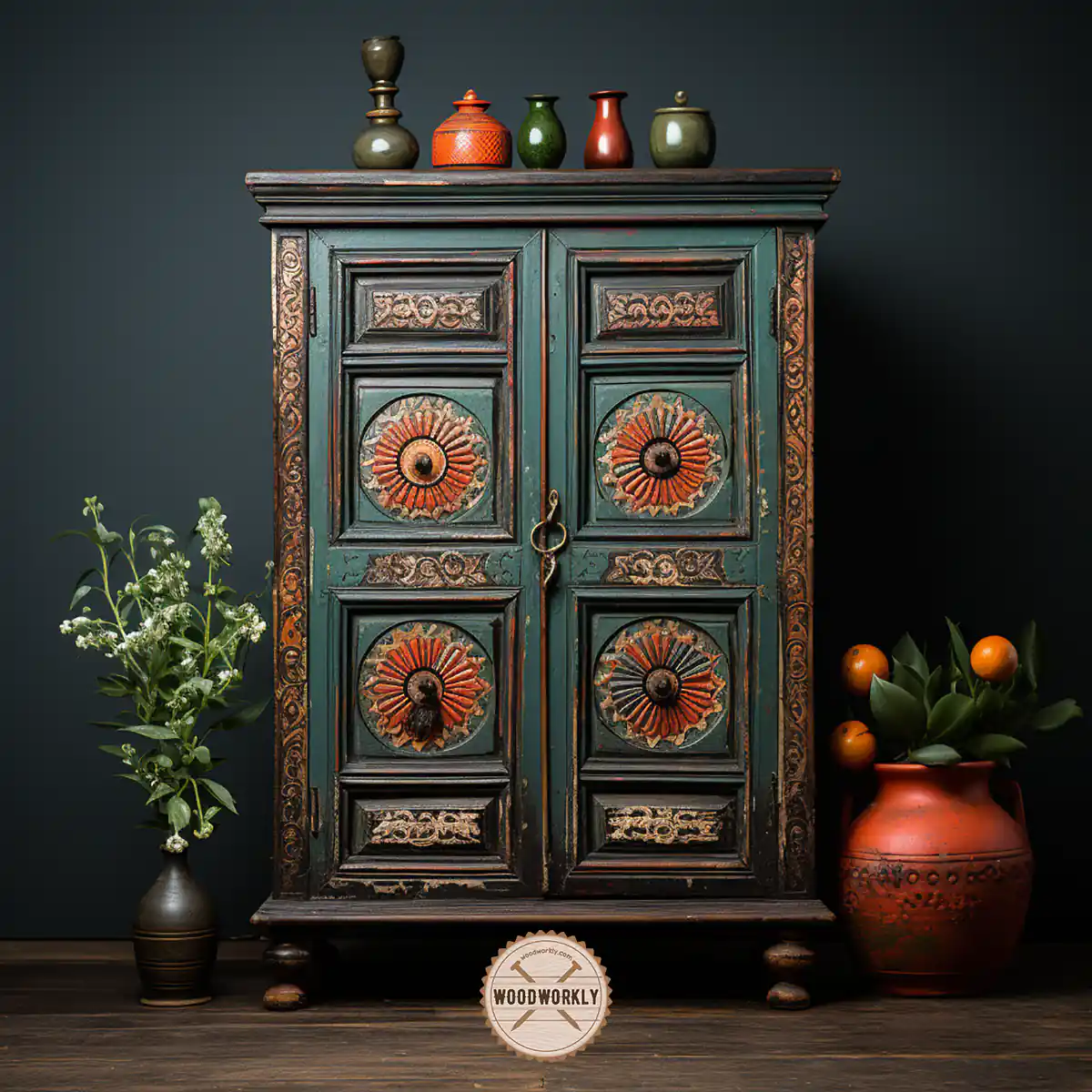
Marine-Grade Paints
If you’re looking for the best of the best when it comes to painting teak wood, marine-grade paint is a top choice.
This paint is specifically designed for use on boats, which endure some severe conditions and require maximum durability.
It’s engineered to resist mildew, mold, and the corrosive effects of saltwater.
Advantages of Marine-Grade Paints:
- Exceptional durability and resistance to harsh conditions.
- Specifically designed to combat mildew and mold growth.
- Ideal for outdoor teak wood furniture in coastal areas.
Disadvantages of Marine-Grade Paints:
- Can be relatively expensive compared to other paint types.
- May require more specialized equipment and expertise for application.
When selecting the best paint for your teak wood project, consider your specific needs and the intended use of the furniture.
Oil-based paints provide a classic, long-lasting finish for outdoor teak wood, while water-based paints offer a quick and eco-friendly solution.
If you’re seeking ultimate durability in coastal or marine environments, marine-grade paint is your top choice.
Your choice of paint can significantly impact the appearance and longevity of your teak wood furniture, so choose wisely.

Supplies You Will Need To Paint Teak Wood
Before a teak wood painting project, it’s necessary to have the right materials and tools in your sight to ensure a smooth and successful transformation.
Here’s a list of essential supplies that will help you achieve the best results:
- 120 Grit Sandpaper and 220 Grit Sandpaper:
- The 120-grit sandpaper helps even the texture and open wood pores, while the finer 220-grit sandpaper ensures a smoother finish.
- Sanding Block or Power Sander:
- A sanding block or power sander is a must for efficiency when dealing with larger teak furniture.
- Cloth or Rag:
- These are essential for general cleaning, wiping away dust, and applying cleaning solutions.
- Trisodium Phosphate (TSP):
- TSP is a powerful cleaner that helps remove grime and prepare the surface for painting.
- It’s particularly useful for weathered teak that needs restoration.
- Rubber Gloves and Masking Tape:
- Rubber gloves protect your hands while masking tape helps create clean lines and protect areas you don’t want to paint.
- Paintbrush:
- A high-quality paintbrush is necessary for applying primer and paint to your teak wood furniture. Choose the appropriate type of brush depending on the type of paint you’ll use.
- Exterior Wood Paints:
- Use paint specifically designed for exterior wood, as it’s formulated to withstand the elements.
- Ensure it suits your teak wood and adheres well.
- Stain-Blocking Primer:
- To prevent any oil in the teak from bleeding through and affecting your paint job, a stain-blocking primer is a must.
- Wood Finish:
- To protect and enhance the longevity of your painted teak wood, a wood finish or sealer is essential. It provides protection against moisture and UV rays.
Having these supplies readily available ensures that your painting project goes smoothly from start to finish.
Proper preparation and the right materials are key to achieving a beautiful, long-lasting result when painting teak wood.
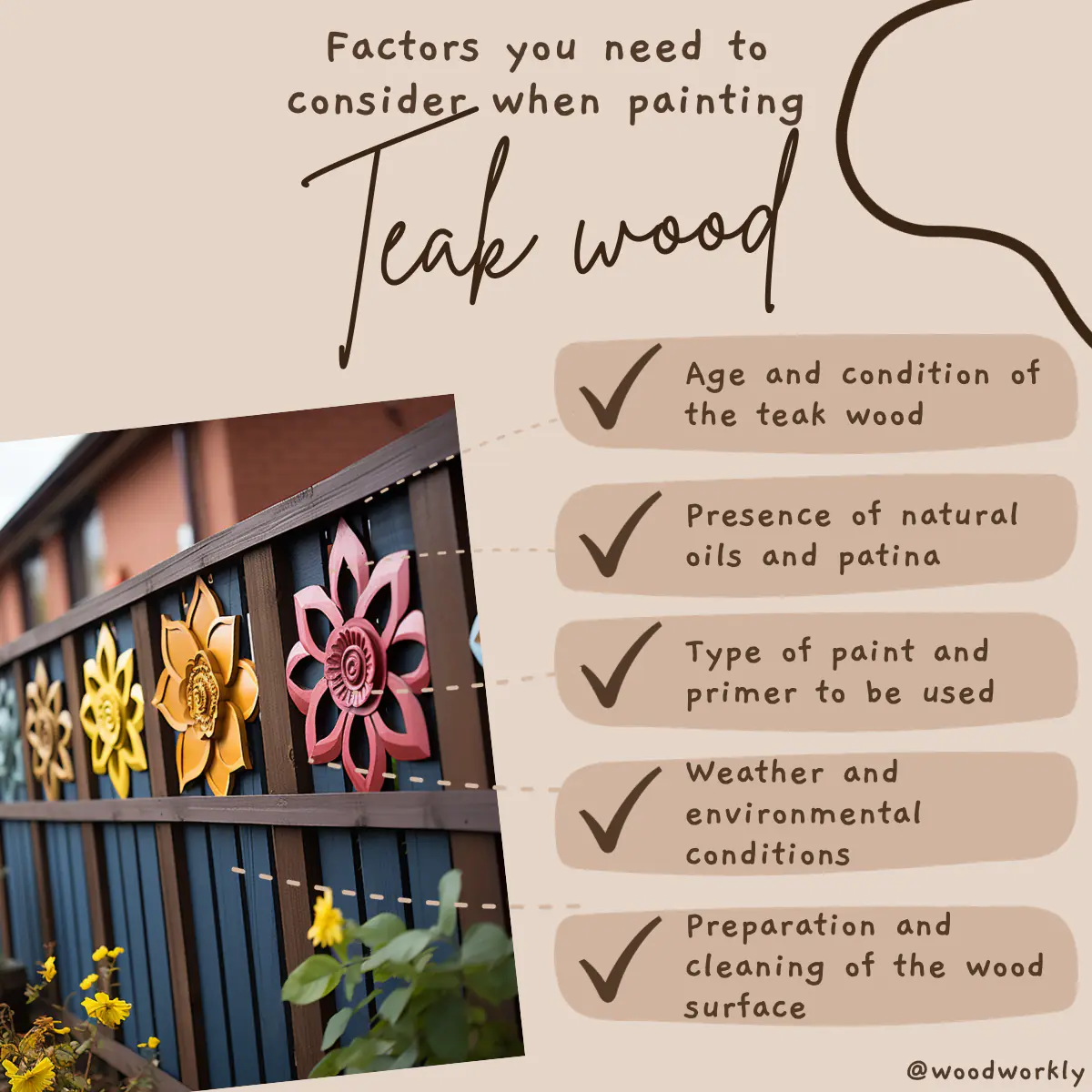
How To Paint Teak Wood Furniture
Painting teak wood furniture can help preserve its beauty and extend its durability.
Whether you’re looking to refresh the original colour of teak wood or give it a new color, here’s a step-by-step guide to getting you started:
1. Clean The Wood
Begin by thoroughly cleaning the teak wood surface. Use a mild detergent and a brush to scrub away any dirt, grime, or mildew.
Wash the wood with fresh water and let it air dry thoroughly.
2. Sand The Wood
Although sanding teak isn’t necessary before painting, it can provide an extra layer of protection against peeling.
Use the necessary grit sandpapers to sand the surface of the teak, making sure to sand in the direction of the wood grain.
3. Apply A Primer
For a perfect paint adhesion, apply a primer to the sanded surface. You can use a brush or roller to evenly coat the teak wood with primer.
4. Paint The Wood
Using a brush or roller, apply paint to the teak wood surface. Be sure to follow the direction of the wood grain while applying the paint.
If you’re using latex paint, a synthetic bristle brush works well, while for oil-based paint, a natural bristle brush is suitable.
Allow the paint to dry fully before adding a second coat.
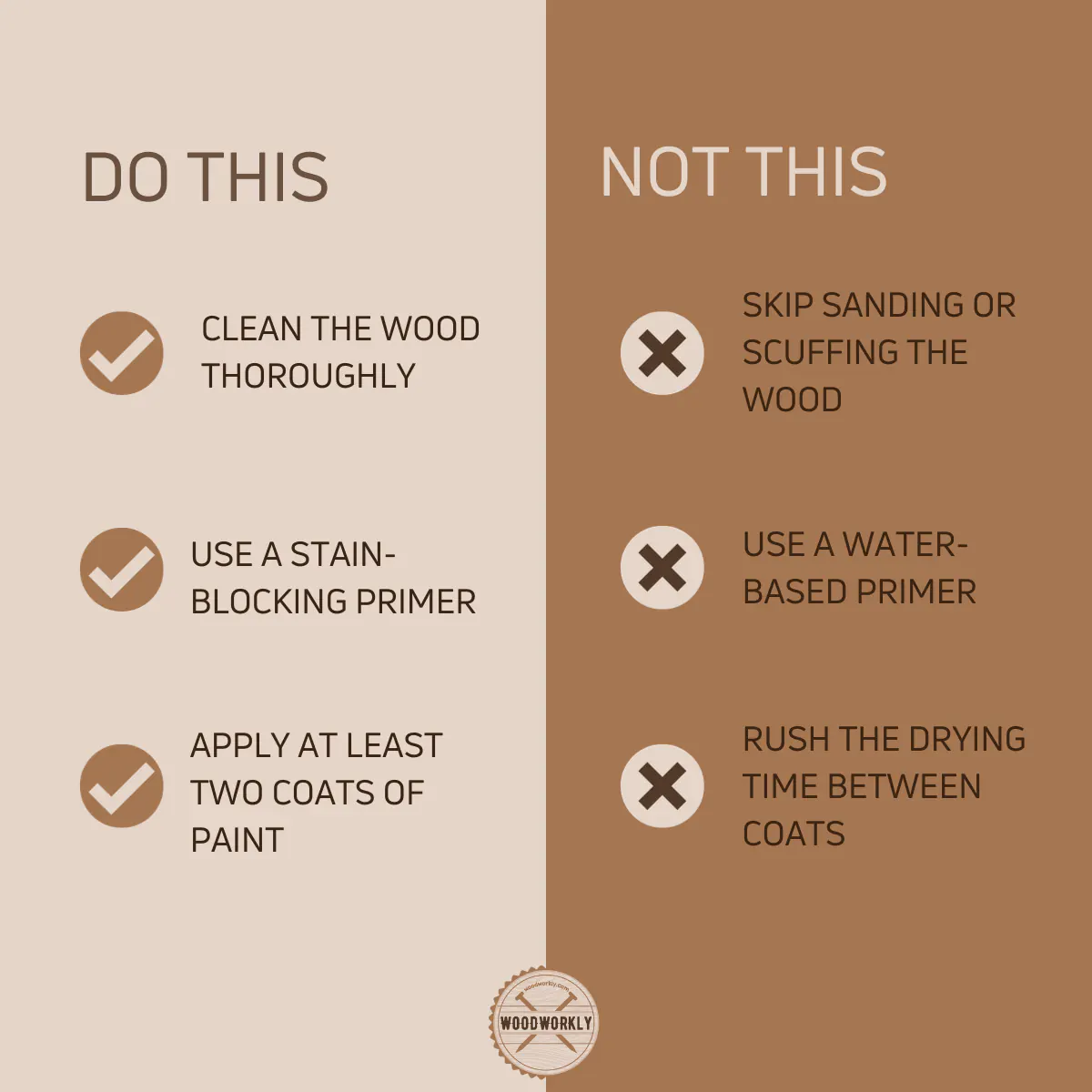
5. Apply A Sealer
After the paint has dried, it’s important to apply a sealer to protect the painted surface and prevent peeling. The sealer acts as a barrier against moisture and UV damage, extending the life of your paint job.
The sealer should also be dry completely before using the furniture.
Once you’re done with the project, don’t forget to clean your acrylic paint brush properly.
By following these steps, you can transform your teak wood furniture and enjoy its beauty for years to come.
Keep in mind that for the best results, you might consider seeking the assistance of professionals to ensure an even, long-lasting finish.
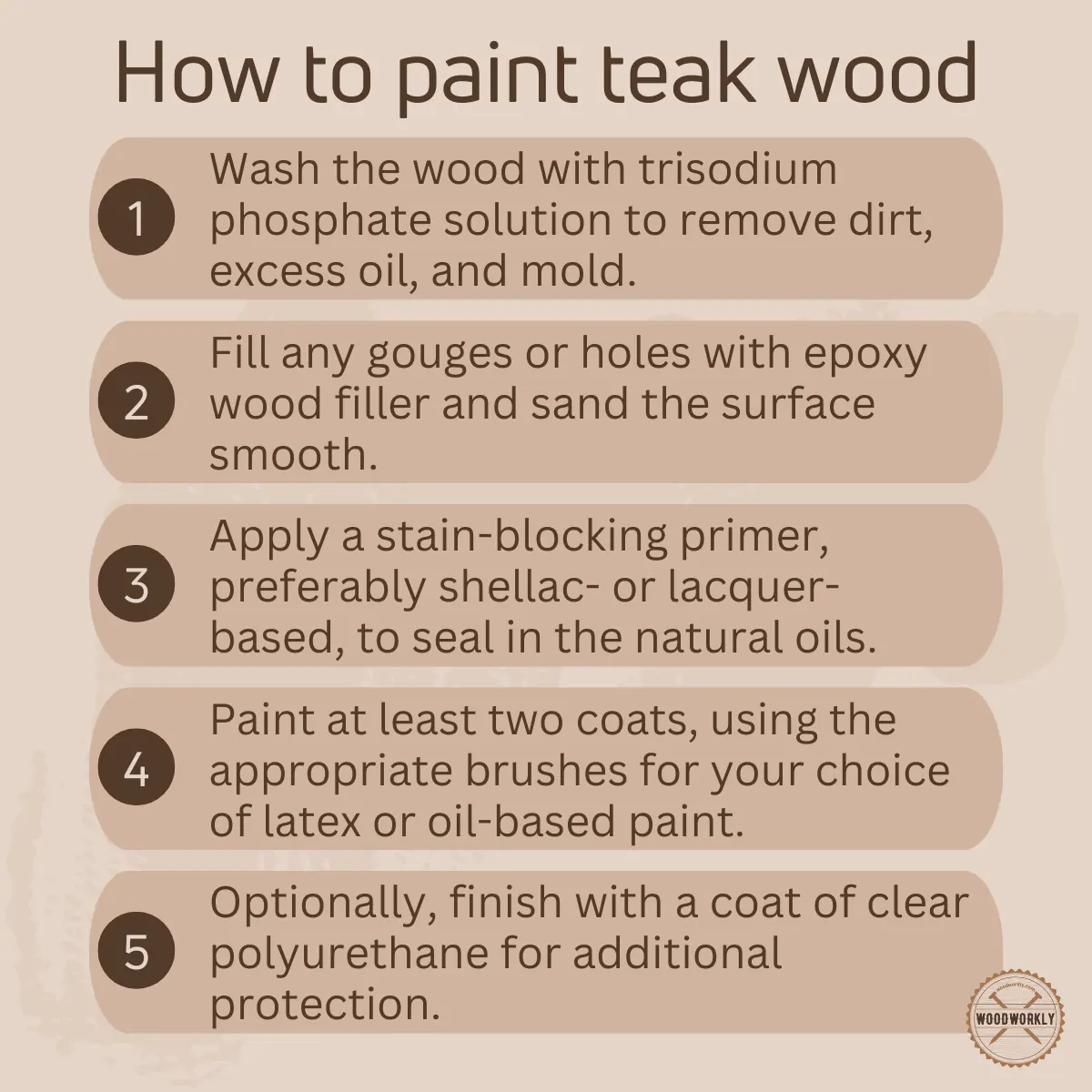
Next, we’ll explore some valuable tips for painting teak wood properly to help you achieve the best results.
Tips For Painting Teak Wood Properly
Here are the tips you need to follow when painting teak wood properly without making any mistakes.
Consider the Weather
Choose a day with warm, sunny weather and low wind levels for your painting project.
Working outdoors is a must, and these conditions will help the paint adhere properly.
Clean and Sand Thoroughly
Clean the teak furniture thoroughly with soapy water or a suitable cleaning solution.
Make sure to remove all dirt and dust, as any residue can affect paint adhesion.
After cleaning, check for any holes or dents, filling them as needed. Lightly sand the furniture to create a surface with tiny scratches for the paint to adhere to.

Apply a Primer
For a long-lasting finish, apply an acrylic primer to even out the surface and prevent stains. Priming also reduces the amount of paint required for the second coat.
Use a paintbrush or roller for this step, then let the primer dry completely before moving on.
Check out, How Many Coats Of Primer On Wood!
Use a Spray Can for Even Coverage
Teak wood’s uneven and rugged surface can make it challenging to apply paint evenly with a brush.
Therefore, using a spray can ease the process and turn the final product into a masterpiece.
Maintain a distance of about a foot from the surface when spraying.
After the first coat dries completely, sand the furniture again with fine sandpaper to create new scratches for paint adhesion.

Allow for Adequate Drying Time
After painting, let the paint dry for about a week before using it. This ensures the best results.
Once dry, consider applying furniture oil or exterior timber paint for added protection.
Avoid Sharpen or Harsh Tools
When cleaning, use a soft cloth, tack cloth, or a soft plastic brush.
Read to know, Tak cloth alternatives for cleaning wood.
Avoid metal brushes or steel wool, which can scratch and damage the wood’s finish.
Don’t use pressure washing, as the high-pressure water can damage the teak.
By following these tips, you can give your teak wood furniture a fresh and attractive look that will stand the test of time.
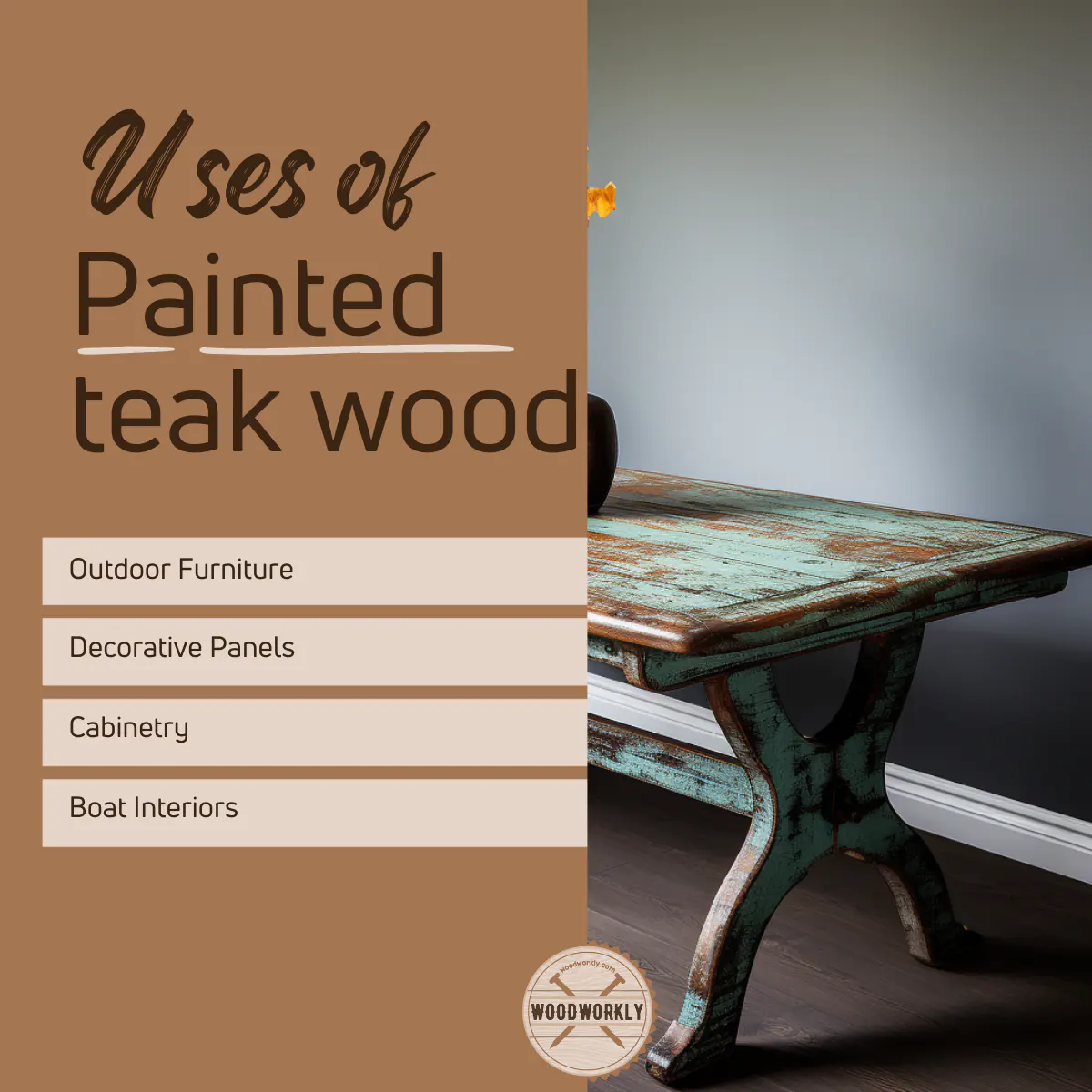
Next, we’ll explore how long paint typically lasts on teak wood.
How Long Does Paint Last On Teak Wood?
Before you decide to paint your teak wood furniture, it’s important to understand that teak has a high natural oil content. These oils are what give teak its unique durability and resistance to rot and decay.
However, these oils can also be a challenge when it comes to painting. Due to the continuous release of natural oils, your painted teak furniture will likely require annual repainting.
The frequency of repainting may vary depending on the climate and exposure to the elements. In general, you can expect to need to repaint your teak furniture every year to maintain its appearance.
Additionally, it’s important to consider that the weathering process of teak wood can affect the longevity of your paint job.
Teak wood typically turns grey within 5-12 months, depending on the climate. Teak that is well-protected and shielded from the elements will take longer to weather.
While the durability of a painted teak wood finish may be limited due to the wood’s natural oils, regular maintenance and repainting can help keep your outdoor teak furniture looking fresh.
Be prepared to invest some time and effort into this annual painting process to maintain the beauty and protection of your teak wood furniture.

How to Maintain and Care for Teak Wood?
Whether you have painted or non-painted teak wood, proper care ensures that it stays in excellent condition and continues to beautify your space for years to come.
Now, let’s see how to maintain and care for both non-painted and painted teak wood separately.
1. Caring for Non-Painted Teak Wood
Routine Cleaning
Teak is remarkably easy to clean. Use a soft brush, mild dish soap, and water to remove dirt and grime.
You can also add vinegar to tackle stains. Always scrub with the grain for the best results.
Teak Oil vs. Sealer
It’s a common misconception that teak wood needs regular oiling.
In reality, outdoor teak furniture should not be oiled because the oil evaporates in the outdoor environment taking some of the wood’s natural oils with it.
This can lead to dryness. Plus, teak oil can go bad due to poor decomposition.
Instead, use teak sealers that lock the wood’s natural oils and offer protection from sunlight, humidity, and mold, minimizing the weathering process and maintaining the teak’s golden color.
Read to know, Teak Oil Advantages and Disadvantages!
Winter Care
If you experience winters with high moisture levels, it’s best to bring teak furniture indoors.
If this isn’t possible, ensure that water doesn’t stand directly on your teak furniture. If you notice mildew, clean your teak furniture promptly.
Black areas on outdoor teak furniture are usually natural wood mold spores and can be easily removed.
Read to know, how to protect teak wood outdoor furniture from the elements.
Protection from Bird Droppings
Bird droppings can stain wood, so remove them promptly to prevent damage.
Read to know about Staining Teak Wood!
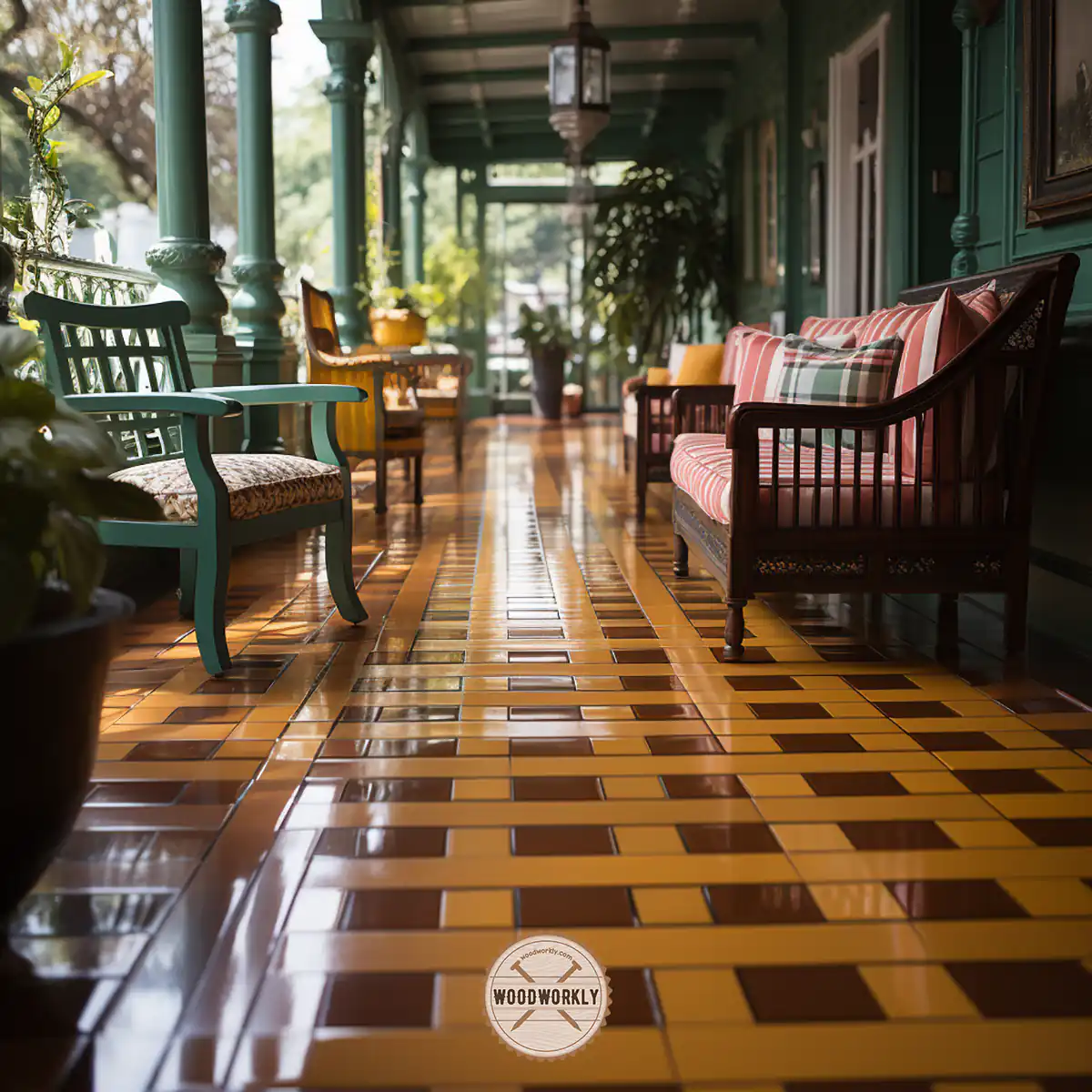
2. Caring for Painted Teak Wood
Preparation
Due to the wood’s natural oils, it’s essential to start with a shellac or lacquer-based primer to prevent bleeding of oils through the primer.
Painting Process
Apply the first coat in the direction of the wood’s grain, allow it to dry, and apply a second coat.
To finish the paint job, you can apply a varnish for added protection and shine.
Regular Maintenance
Understand that painted teak wood may require repainting every year due to the continuous release of natural oils from the wood.
Regularly inspect the painted surface and repaint as needed to maintain the desired appearance.
By following these maintenance tips, you can ensure your teak wood furniture remains in excellent condition, whether you prefer it’s natural or have chosen to paint it for a different appearance.
Proper care not only extends the life of your teak wood furniture but also keeps it looking beautiful year after year.
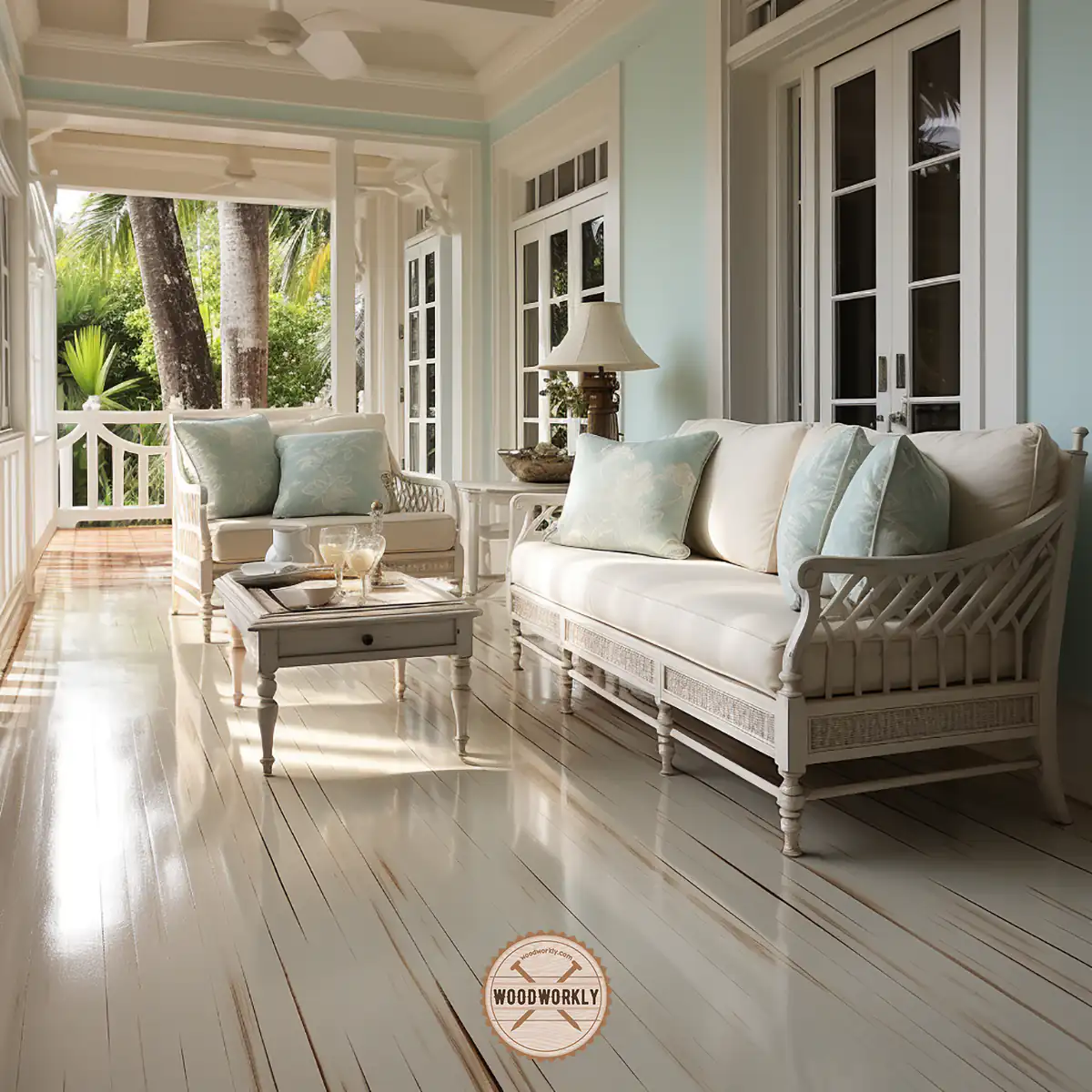
So, let’s answer some frequently asked questions.
FAQs
Is it a good idea to paint teak wood?
Painting teak wood is not highly recommended due to its natural oils that prevent rot and create a shiny patina but also inhibit paint adhesion and can bleed through finishes. However, you might have some success if the wood is old and weathered, provided that you follow proper preparation steps.
What preparation is necessary before painting teak wood?
Thoroughly wash the wood using a strong detergent mixed with trisodium phosphate to remove dirt, excess oil, and mold, followed by rinsing with clean water. Fill any holes or gouges with epoxy wood filler, scuff the wood with 220-grit sandpaper, and apply a stain-blocking primer to prevent the natural oils from bleeding through.
Can you paint teak wood without sanding it?
Sanding teak wood before painting is not strictly necessary, but scuffing it with 220-grit sandpaper is recommended as an additional precaution against peeling.
What type of primer should be used on teak wood?
A shellac- or lacquer-based primer is recommended to seal the natural oils in teak wood and prevent them from bleeding through the paint. Some high-solids latex primers may also work, but a shellac- or lacquer-based product is safer.
How many coats of paint are needed when painting teak wood?
At least two coats of paint are required, regardless of whether you are using latex or oil-based paint. An optional coat of clear polyurethane can be applied afterward for extra protection.
What types of paint can be used on teak wood?
Both latex and oil-based paints can be used on teak wood, provided that you have properly sealed the wood with a suitable primer beforehand.
How do you clean teak wood before painting?
Use a strong detergent mixed with trisodium phosphate to wipe down the wood, removing dirt, excess oil, and mold, and then rinse the wood thoroughly with clean water.
What should be done if the teak wood’s natural oils bleed through the primer?
If the natural oils bleed through the primer, apply another coat of the stain-blocking primer before proceeding with painting.
Is it necessary to use a clear coat after painting teak wood?
Applying a clear coat of polyurethane after painting is optional but can provide extra protection to the paint job.
How do you deal with holes or gouges in teak wood before painting?
Fill any holes or gouges with epoxy wood filler, making sure to use it within 5 minutes of mixing and sanding it flat with 120-grit sandpaper after it sets.
Did I cover all you wanted to know about: Can You Paint Teak Wood?
In this article, I deeply discussed whether can you paint teak wood following the right steps.
In this journey of exploring the story of painting teak wood, we’ve learned that painting teak wood is not only possible but can give a new life to your furniture.
You can paint teak wood. But, when deciding to paint teak wood, you should be aware of these pros and cons. The choice of paint, proper preparation, and maintenance are essential to ensure a successful and long-lasting finish on your teak wood furniture.
While there are both advantages and disadvantages to painting teak wood, understanding the process and choosing the right materials are essential for a successful project.
We’ve examined the best paint options, the necessary supplies, and also I provided a step-by-step guide to help you achieve a stunning, long-lasting finish.
So why wait? Begin your teak wood transformation today and let your creativity run wild!
Enjoy the process and the beauty and durability of your painted teak wood furniture.